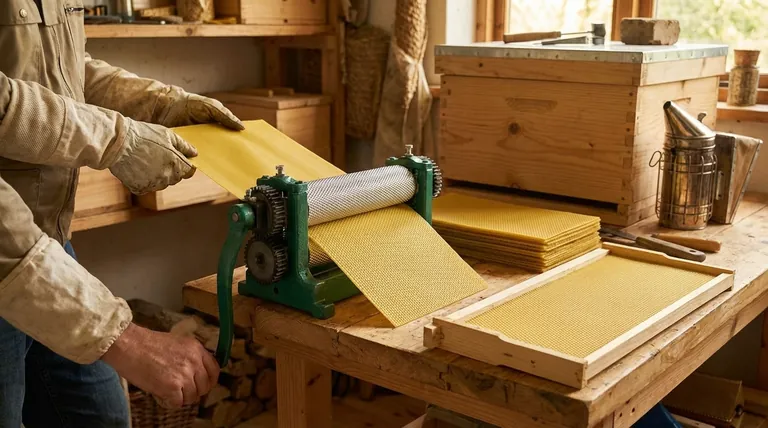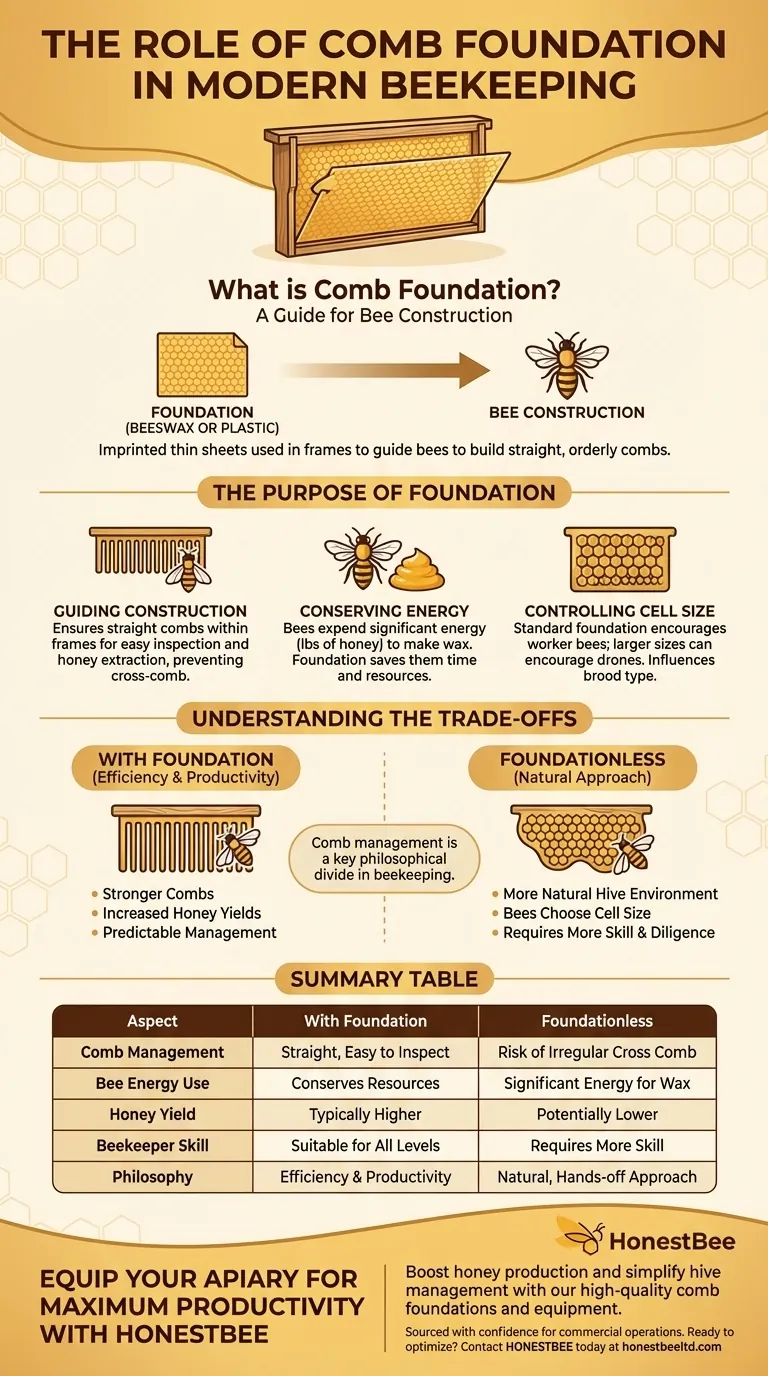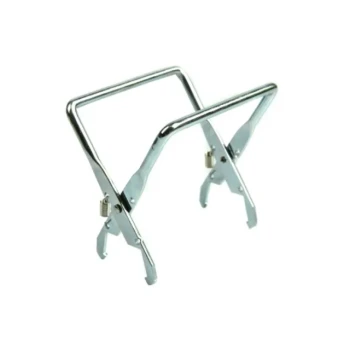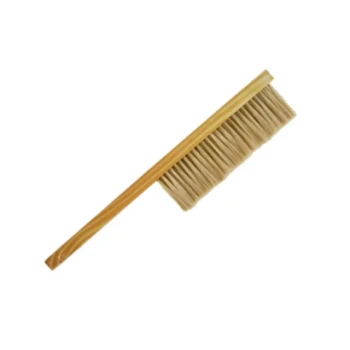Yes, humans manufacture comb foundations for beehives. These are thin sheets, typically made of beeswax or plastic, that are imprinted with the hexagonal pattern of a honeycomb. Beekeepers place these sheets into wooden frames, providing a guide for the bees to build their comb upon, which is a significant intervention compared to the fully natural comb bees would construct in the wild.
Comb foundation is a critical tool in modern beekeeping, used to impose order on the hive's internal structure. It represents a trade-off between the bee's natural instincts and the beekeeper's goals of efficiency, manageability, and productivity.

The Purpose of Comb Foundation
In a natural setting, bees build their comb from scratch, drawing it down from the ceiling of a cavity. While perfectly functional for the bees, this natural comb can be irregular and difficult for a beekeeper to manage. Foundation is the solution to this challenge.
Guiding Bee Construction
The primary purpose of foundation is to guide the bees to build straight combs within the removable frames of a modern beehive.
Without this guide, bees often build "cross comb," connecting adjacent frames or building comb in irregular shapes. This makes it impossible to inspect a frame without cutting and destroying the comb, harming brood and spilling honey.
Conserving Bee Resources
Producing beeswax is an incredibly energy-intensive process for bees. It is estimated they must consume several pounds of honey to produce a single pound of wax.
By providing a foundation, the beekeeper gives the bees a "head start." The bees can use the provided base and build upon it, saving them a tremendous amount of time and energy that can then be redirected toward foraging, raising brood, and producing honey.
Controlling Cell Size
Foundation allows beekeepers to influence the type of brood the queen lays.
Foundation is manufactured with specific cell-base sizes. Standard sizes encourage the bees to build cells for female worker bees. Larger sizes can be used to encourage the creation of cells for male drones, although this is less common as most beekeepers aim to limit the drone population.
Understanding the Trade-offs
Using foundation is the industry standard, but it is not without its debates. The choice between using foundation and allowing bees to build their own comb is a key philosophical divide in beekeeping.
The Case for Foundation
Proponents of foundation point to its undeniable efficiency. It leads to stronger combs that can withstand the force of mechanical honey extractors, increases honey yields by saving bee energy, and makes hive inspections predictable and non-destructive.
The Case for "Foundationless" Beekeeping
Some beekeepers prefer to use frames without any foundation. This allows the bees to build comb naturally, according to their own instincts and needs.
Advocates for this method argue it creates a more natural hive environment and allows bees to build the cell sizes they see fit. This approach, however, requires more skill and diligence from the beekeeper to prevent unmanageable cross comb.
Potential Downsides of Foundation
Commercial beeswax foundation can sometimes contain trace amounts of pesticides or other chemicals that have accumulated in the wax supply over time. Furthermore, some argue that restricting bees to a uniform cell size is an unnatural constraint on the colony's development.
Making the Right Choice for Your Goal
Your decision to use foundation should be based on your specific beekeeping philosophy and what you hope to achieve.
- If your primary focus is maximizing honey production and ease of management: Using foundation is the standard, most efficient, and most reliable method for a productive apiary.
- If your primary focus is "natural" beekeeping and colony health: Consider foundationless beekeeping to allow your bees to build comb entirely on their own terms, but be prepared for more intensive management.
Understanding the role of comb foundation empowers you to make a deliberate choice that aligns with your beekeeping objectives.
Summary Table:
| Aspect | With Foundation | Foundationless |
|---|---|---|
| Comb Management | Straight, easy-to-inspect combs | Risk of irregular cross comb |
| Bee Energy Use | Conserves bee resources for foraging | Bees expend significant energy on wax production |
| Honey Yield | Typically higher due to saved energy | Potentially lower |
| Beekeeper Skill Level | Suitable for all levels | Requires more skill and diligence |
| Philosophy | Efficiency and productivity | Natural, hands-off approach |
Equip Your Apiary for Maximum Productivity with HONESTBEE
As a commercial apiary or beekeeping equipment distributor, your success hinges on efficiency and yield. HONESTBEE supplies the high-quality comb foundations and beekeeping equipment you need to achieve it.
- Boost Honey Production: Our foundations give your bees a head start, conserving their energy for higher honey yields.
- Simplify Hive Management: Ensure straight, strong combs that are easy to inspect and manage, saving you time and labor.
- Source with Confidence: We provide reliable, wholesale-focused supplies tailored for commercial operations.
Ready to optimize your hives? Contact HONESTBEE today to discuss your wholesale needs and let us help you build a more productive and manageable apiary.
Visual Guide

Related Products
- Manual Beeswax Comb Foundation Machine Wax Foundation Mill Embossing Machine
- Food Grade Plastic bee Foundation for Bee Frames
- Beeswax Foundation Sheets Beehive Foundation for Wholesale
- Professional Frame Preparation: The HONESTBEE Electric Wire Embedder
- Manual Spur Wheel Wire Embedder for Foundation
People Also Ask
- Why is it beneficial to make your own beeswax foundation? Gain Control Over Cost, Purity & Hive Health
- What texture is embossed on the beeswax foundation machine? The Precise Worker Bee Cell Pattern for Hive Efficiency
- What is the use of a comb foundation mill? Boost Honey Production with Strategic Hive Control
- What is the function of a beeswax foundation machine? Boost Hive Efficiency and Honey Production
- How do honeybees use wax in their hives? The Key to Colony Survival and Structure



















